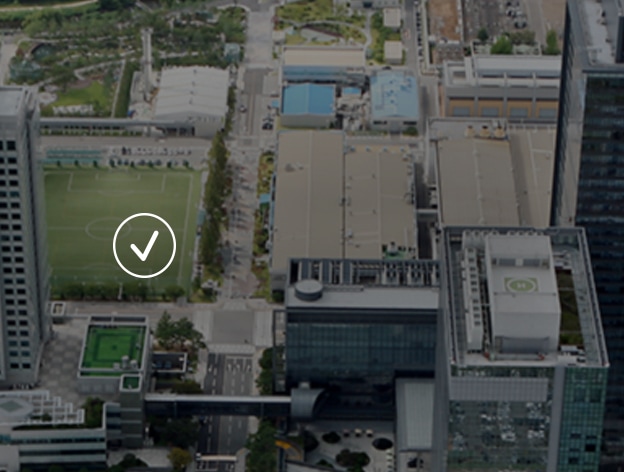所有三星的工廠皆獲得環境管理系統認證,並落實生態管理。但我們為環境所做的努力不僅止於工廠。在所有的工廠內,我們確認環境問題並找出解決方案。藉由精準確定問題根源所在,並在整個工廠系統採取預防措施,我們確保這些解決方案並非只是暫時性的,或「太少也太遲」。而在工廠之外,我們也積極與當地社區一同投入生物多樣性對談工作,保護生態系統。
我們在所有工廠落實永續的環境管理
為了實踐環保管理,三星電子已根據國際環境管理標準管理工廠。


具環保意識的工廠 KPI
環境管理系統認證率


達成
100%
2019年* 全球 36 個生產據點獲得 ISO14001 及 OHSAS18001 認證
我們不斷致力於減少溫室氣體的排放
面對氣候變遷,具有能夠以企業層級落實的行動。其中一種措施為客觀透明衡量現有表現,同時確認潛在的內部改善。為了達到此目的,三星電子每年透過第三方,持續查證其實際的溫室氣體排放量。此外,根據內審員的診斷,我們找尋降低排放量的方法,並持續採取方法加以改善。我們努力的重點之一就是減少溫室氣體,尤其是持續致力降低對全球暖化造成重大影響的含氟氣體排放,至今已有長足進展,特別是在我們的半導體製造營運上。


韓國三星據點累計 F-Gas 減量情況
(單位 : 10,000 噸二氧化碳當量)


2019 年溫室氣體排放減量
36% Expansion of renewable energy use
35% Processed F-gases treatment
12% Introduction of energy-efficient facilities
9% Manufacturing process efficiency improvement
7% Increase facility efficiency
0.4% Other
0.1% Lighting Improvement
依循當地法律和內部法規,嚴格管理化學物質
為了防範可能發生的化學品管理意外事件,從購買到處置的每個階段,我們皆系統性地加以管理。我們每個工廠處理化學物質的員工,都必須在採購前對該化學物質進行初步評估。評估化學物質為可使用後,我們才會將其登記並使用。
使用後,化學廢棄物將透過個別處理程序安全地棄置。


Preliminary chemical evaluation system
- 01 Preliminary chemical evaluation
- Request from the relevant department
- Preliminary review¹⁾ by experts
- Deliberation on review outcomes
- Not for use
- Approval
- Use
- 02 Purchase
Inventory system
- 03 Warehouse registration (place of use)
- 04 Use (inventory management)
- 05 Disposal
Review the optimum management process by analysing hazardousness and danger to the environment, health and safety (EHS)
為了維持地球的健康,我們支持生物多樣性保存活動
三星電子領導層和員工都身體力行,致力於打造更健康的生態環境。三星電子的生物多樣性保存行動都是基於共同的基本理念,規劃活動宣傳其重要性,並同時鼓勵領導層和員工主動參與其中。


三星電子的生物多樣性保護政策
基本理念
三星了解生態系統與生物多樣性的益處及重要性。
為降低對生物多樣性有害的影響,我們積極參與生態系統保護行動。
行動計劃
讓所有員工了解到,
保護生物多樣性是
生態管理重要價值的一環。透過評估及分析產品
在生命週期對生態系統與生
物多樣性的影響,盡可能降低出現
任何負面影響。在韓國及海外所有工廠,
優先考慮擁有高價值生物
多樣性的地區,發展能達成當地需求
的生物多樣性保護活動。不斷與員工、當地社區、
非政府組織與其
他利害關係人溝通,並為促進
當地社區的生物多樣性保護
工作做出貢獻。
保護瀕危物種的棲息地
在製造工廠所在地區,我們已確認瀕危物種與其棲息地,並與相關組織,包括當地社區、公共協會與學術界,共同落實生物多樣性保護活動。
鄰近韓國工廠的瀕危物種
-
水原市
-

兩棲類
1
-
-
龍仁市
-

兩棲類
2
-

昆蟲類
1
-
-
華城市
-

鳥類
12
-

兩棲類
2
-

昆蟲類
1
-

植物
2
-
-
牙山市
-

鳥類
5
-

兩棲類
2
-
其他
1
-
-
光州市
-

哺乳類
2
-

鳥類
1
-

Fish
1
-

昆蟲類
1
-

植物
2
-
-
龜尾市
-

哺乳類
1
-

鳥類
1
-

魚類
1
-

昆蟲類
1
-

植物
2
-
其他
1
-
白枕鶴保育活動:Jaepyeong(Jaedurumi 及 Haepyeong 溼地)復原活動
2013 年,三星電子在尚慶北道龜尾市的工廠,成為韓國首座與中央及地方政府與大學簽署生物多樣性保護合作夥伴的工廠。自此,我們開始支援兩對來自荷蘭的瀕危物種白枕鶴(韓國天然紀念物第 203 號)的人工授精。在 2016 年 4 月,鳥類生態環境研究協會成功繁殖幼鳥。這將協助重建候鳥棲息地 Haepyeong 溼地的生態系統,也是保護生物多樣性的卓越貢獻。
海岸沙丘保護
我們位於忠南清道的 Onyang 工廠,自 2008 年起便與錦江流域環境辦公室合作保護海岸沙丘,這些沙丘是中國白鷺與麗斑麻蜥這兩種瀕危物種的家。目前我們在保寧市支援例如海洋淨化、清除入侵的外來植物、保護 Sohwang 沙丘;而在牙山我們則支援芒草棲息地的建立。
根除外來魚種/植物
我們位於京畿道的 Giheung 與 Hwaseong 工廠每年都會在烏山及 Woncheonri 溪舉辦生態系統保護活動,清除外來物種、餵食野生動物,並舉辦活動以保護環境。

